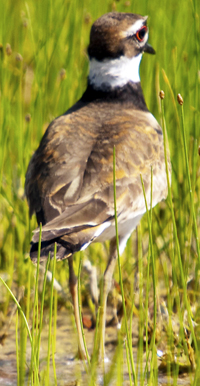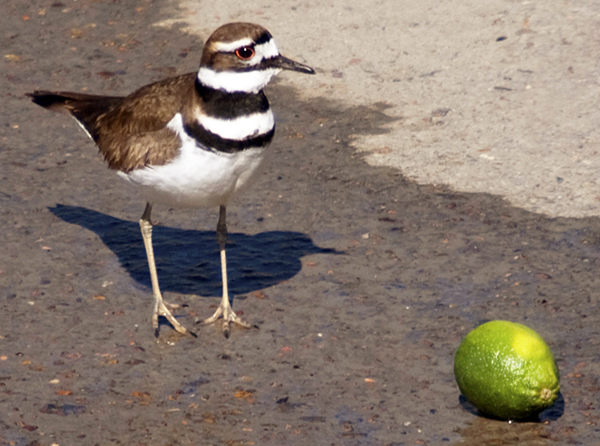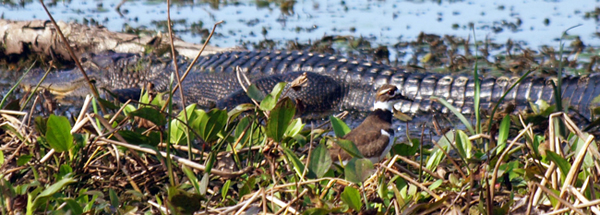Killdeer
Today, a special bird. The University of Houston's College of Engineering presents this series about the machines that make our civilization run, and the people whose ingenuity created them.
I moved to Roseburg, Oregon, in 1946 -- same year the movie Canyon Passage came out. It was a western romance with Susan Hayward and Dana Andrews, set in the Rogue River Valley, sixty miles south of Roseburg. All I remember of the movie is song-writer Hoagy Carmichael. He was the Greek Chorus in the movie.
He kept underscoring the action with his songs, and they were all hits: Ole Buttermilk Sky, I'm Gettin' Married in the Mornin', and one called Rogue River Valley, with these words:
[Audio clip: There by the river We'll find the trail of dreams Donkey don't you dare to dally Can't you hear the killdeer's song?]
We all sang it, but I had no idea what a killdeer was, nor did I know its song. I wasn't into birds. Now I live near the Texas gulf coast and I've come to know killdeers very well. They're a plover that likes to wade in water.
As for that odd name -- well -- listen to its song as it takes flight. [Include the Kildeer's flight song] It sounds a little like "kill-dee, kill-dee" and we hear a lot of that. Its Latin name, Charadrius Vociferus, literally means a noisy yellowish bird.

A killdeer is pretty, but not really yellow. Its brown wings are edged with black and white trim. It has a white belly, black and white bands about its neck and head. Its black eyes are rimmed with red, and its orange tail unfolds in flight.
 But its most distinctive feature is its cry. Get too close and it flies off crying kill-dee. A mother killdeer is very canny about keeping us away from her young. She'll pretend to have a hurt wing and hobble off, leading us away from her nest -- all the time yelling at us. When she's moved us far enough away, she unfurls her colorful wings and tail, and takes flight -- scolding us, kill-dee, kill-dee.
But its most distinctive feature is its cry. Get too close and it flies off crying kill-dee. A mother killdeer is very canny about keeping us away from her young. She'll pretend to have a hurt wing and hobble off, leading us away from her nest -- all the time yelling at us. When she's moved us far enough away, she unfurls her colorful wings and tail, and takes flight -- scolding us, kill-dee, kill-dee.
The hurt-wing trick won't keep a cow from trampling her nest. So, faced with a big dumb animal, our brave little bird fluffs her feathers and unfolds her colors to frighten the beast away.
Killdeers live year round on waterways in most of America. Some spend summers in Canada and the far North; some winter over in Central America. They haunt our Houston bayous and detention basins year round. Yet we hardly see them in the brush and grass, even while they chitter loudly among themselves. They blend in until we get close and they erupt in flight, color, and sound. Small, fast, and beautiful.
So, after a lifetime humming Hoagy Carmichael's tune about killdeers along the Rogue River, I've finally come to know these tough and beautiful birds here in Texas. Cardinals, doves, sparrows, and blue jays haunt our back yard bird feeders. But the independent killdeer stays off in the watercourses. There, it is they who watch you and me. We are the aliens in their conversation-filled wetland world.
I'm John Lienhard at the University of Houston, where we're interested in the way inventive minds work.
See the Wikipedia Article on the Kildeer. It includes a good example of a killdeer pretending to be hurt. Several You Tube examples also illustrate her act. The Cornell Ornithology Lab provides this excellent page on the Killdeer. And here is Hoagy Carmichael singing Take Me to the Rogue River Valley on YouTube
All photos by J. Lienhard

This killdeer was looking for food in Houston's Bray's Bayou when it found a lime and paused to puzzle over its relevance.

This killdeer appeared to be quite cosy with an alligator.